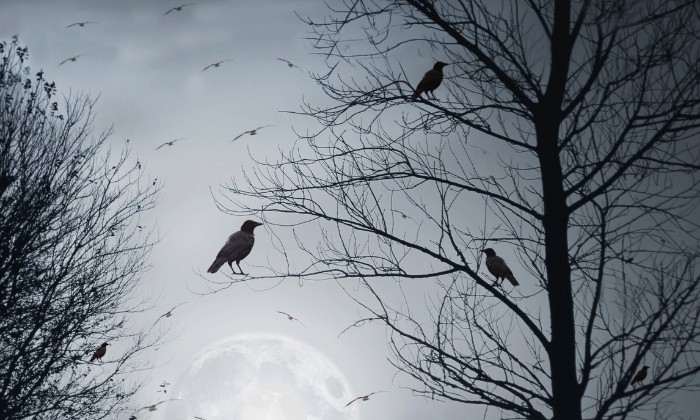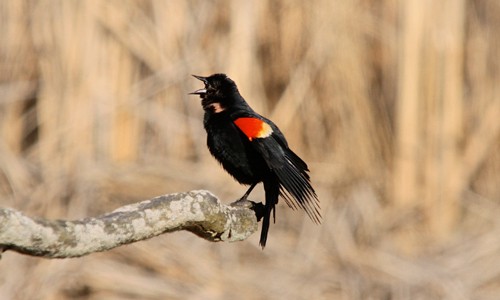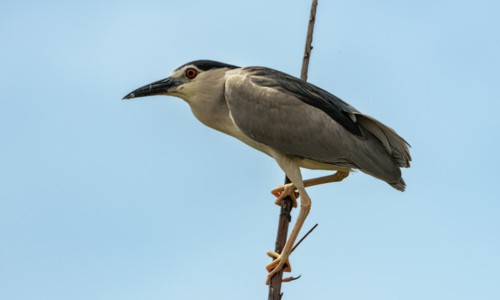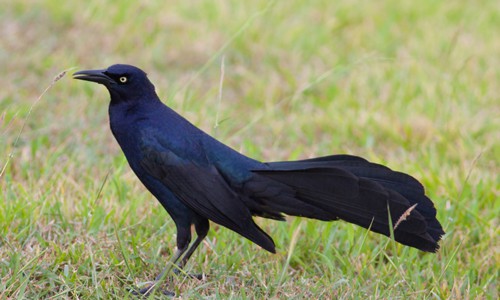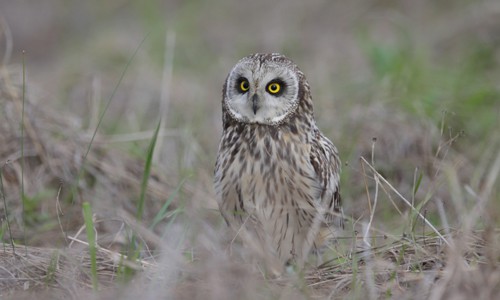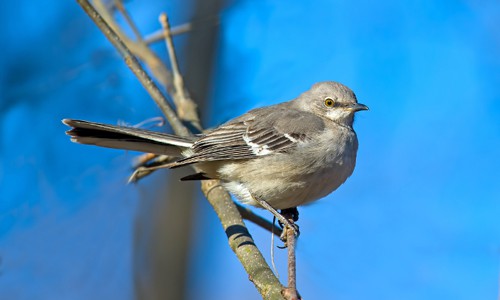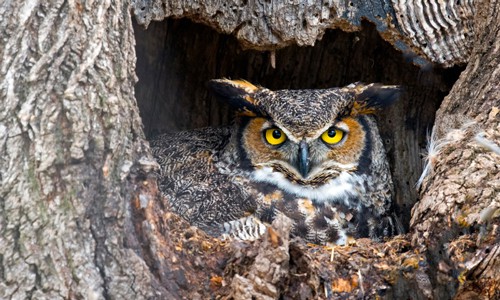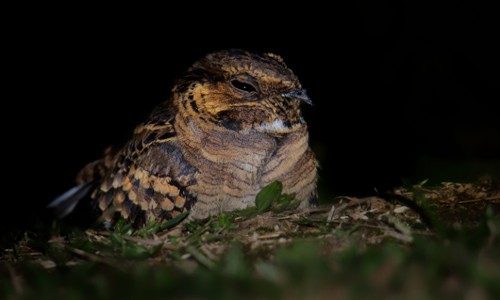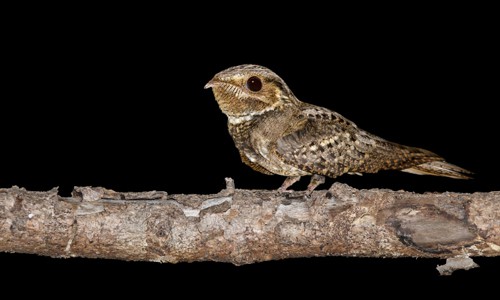Texas has many different types of nocturnal birds, each with unique characteristics.
Discover the fascinating sounds and behaviors of birds that chirp at night in Texas, from the eerie calls of the Eastern Screech Owl to the rhythmic chirping of the Common Nighthawk.
They’ll come in handy if you want to easily identify what kind of bird chirps at night wherever you are in Texas.
Table of Contents
Notable Nocturnal Birds in Texas
Learn about the stars of nocturnal avian life in the lone star state. In this list, we’ll introduce you to the remarkable nocturnal bird sounds you’ll hear when in Texas.
1. Red-Winged Blackbird
| Weight | 1.1 – 2.7 oz |
| Length | 6.7 – 9 inches |
| Wingspan | 12 – 16 inches |
| Features | Black pointed bills, medium-length tail
Red patches on the shoulder with yellow line |
| Sound | Red-winged Blackbird |
This bird is intimately connected to the passage of time because it is known to migrate when the weather begins to cool and then return as a harbingers of the arrival of spring.
The make red-winged blackbird is easily recognized by the bright red and yellow shoulder patches.
Female red-winged blackbirds, meanwhile, lack the bright red shoulder patches and have a more plain appearance.
In the spring, the males of these birds that sing at night produce loud, throaty sounds. These calls are sometimes known as an Okalee Song and used by red-winged blackbirds to warn others to remain off their territory.
2. Black-Crowned Night Heron
| Weight | 1.5 – 2.2 oz |
| Length | 23 – 26 inches |
| Wingspan | 45 – 46.5 inches |
| Features | Light gray feather
Adult heron has black bills and red eyes Short neck and leg |
| Sound | Bird sounds – Black-crowned night heron (Nycticorax nycticorax) |
Black-crowned night herons, also called black-capped night herons, can be spotted all over the state of Texas, particularly in waterways that are overrun with thick vegetation.
These night birds are among the few members of the heron family that are nocturnal and feed on a wide variety of aquatic and terrestrial organisms.
Their scientific name, “Nycticorax,” comes from ancient Greek and means “night raven.” This was inspired in part by their unusual nightly sounds, which range from raspy calls to harsh screams.
3. Yellow-Breasted Chat
| Weight | 1.5 – 2.2 oz |
| Length | 23 – 26 inches |
| Wingspan | 45 – 46.5 inches |
| Features | Light gray feather
Adult heron has black bills and red eyes Short neck and leg |
| Sound | Yellow-breasted Chat Song |
The yellow breasted chat is a medium sized songbird that gives a variety of night sounds especially in spring and summer. They are among the seasonal birds in Texas, and are known to be quite elusive.
These shy songbirds have distinct features like a lengthy tail, a large head, and a pretty hefty beak, yet spotting them can be challenging. They typically hide in thick shrubs and dense vegetation. Thus are often regarded as among those species that are more easily heard than seen.
4. Great-Tailed Grackle
| Weight | 4.0 – 9.0 oz |
| Length | 15 – 18 inches |
| Wingspan | 19 – 22.8 inches |
| Features | Shimmering black feathers, legs, and bills
Yellow eyes |
| Sound | Great-tailed Grackle Calling & Bathing |
Despite its resemblance to crows, the grackle is not a member of the Corvidae family of birds. These birds can adapt to many environments, except for deserts.
Grackles can be easily identified by their streamlined appearance and their special toe arrangement that is adapted for perching.
Great-tailed Grackles produce an impressively wide range of sounds, from beautiful, tinkling notes to calls that are so piercing that they are best heard at a distance. This makes the great-tailed grackles one of the loudest birds in Texas.
5. Short-Eared Owl
| Weight | 11 – 13.5 oz |
| Length | 13 – 17 inches |
| Wingspan | 38- 43 inches |
| Features | Breast features many brown spots
White on the upper body Buffy belly |
| Sound | Short-eared owl sound |
Short-eared owls are known for being one of the owl types that can be found around the world. In the winter, you can often see these birds, which like to be out at night, in Texas’s vast plains.
These owls have striking black rims around their yellow eyes and wings that have a round shape. These animals have amazing hearing, which helps them hunt for small animals and birds.
Short-eared owls give unique “voo-hoo-hoo” calls when they are breeding. Otherwise, they are usually very quiet and inconspicuous.
6. Northern Mockingbird
| Weight | 1.6 – 2.1 oz |
| Length | 8 – 10 inches |
| Wingspan | 12-13.8 inches |
| Features | Gray and brown leather with white spots on wings
Slender body and long tail |
| Sound | A Master of Song: Northern Mockingbird |
In Texas, the Northern Mockingbird is a common backyard bird. Their nightly songs can be heard in neighborhoods all over the state.
These birds are quite common across North America. What makes them unique is that they can keep learning new sounds, making them one of the best birds that sing at night in Texas.
There are more than 200 songs that the Northern Mockingbird can sing when the sun goes down. They can make noises that sound like other birds, insects, animals, and even machines.
7. Eastern Screech Owl
| Weight | 4.6 – 7.9 oz |
| Length | 6.5 to 1o inches |
| Wingspan | 19 – 24inches |
| Features | Stocky and short body
Short/no neck and a big head Brown feather with white spots |
| Sound | Eastern Screech Owl Sounds: Learn their TWO haunting calls! (2023) |
The once forest-dwelling Eastern Screech-Owl has successfully adapted to life in cities. They usually inhabit green spaces like parks and golf courses.
Since these birds are purely nocturnal, you’ll most likely hear their sounds whether you’re relaxing at 9 p.m. or suddenly awake at 1 a.m. Contrary to their name, Eastern Screech-Owls do not screech but more like a low squeal or trill.
8. Great Horned Owl
| Weight | 2.2 – 4 oz |
| Length | 18 – 24.5 inches |
| Wingspan | up to 4.6 feet |
| Features | With horn-like feather tufts on its head
Big round yellow eyes Black, gray, and white feather patches |
| Sound | Great Horned Owl hoot |
The Great Horned Owl is one of the largest owl species, and many of them can be spotted across Texas. With their great vision and heightened sense of hearing, these brown owls are among the best night hunters.
Apart from the size of their wings, which can spread up to 4 feet long, these brown owls are known for their big yellow eyes and the long tufts of feathers on the side of their heads.
Nighttime, during late autumn and early winter, is the best time to listen for the calls of the Great Horned Owl. At this time of year, they establish territories and begin courting potential partners.
9. Common Nighthawk
| Weight | 2 – 3.5 oz |
| Length | 8.6 – 10 inches |
| Wingspan | 20 – 24 inches |
| Features | Speckled brown and gray feather
Long and pointed wings and tail |
| Sound | Voices: Common Nighthawk |
Common Nighthawks are medium-sized raptors found throughout Texas at night. They have pointed wings and medium-length tails.
Only four of the nine identified subspecies of common nighthawks are in Texas. You’ll find Howell in north Texas, aserriensis in central Texas, Chapmani in the southeast, and Henryi in the west.
During the summer, listen for the deep booming sounds evocative of race automobiles as you watch these birds perform magnificent “booming” flight displays in the evening.
10. Common Pauraque
| Weight | 1.8 -2.5 oz |
| Length | 11 – 12 inches |
| Wingspan | 22 – 24 inches |
| Features | Gold, gray, and brown feather
White streaks on throat, tails, and wings |
| Sound | Common Pauraque singing in the evening |
The Common Pauraque are usually spotted on most open fields. However, with their brown, gold, and gray pattern that easily blends with tree barks and shrubs, you’ll have to be very observant.
You will most likely hear the various Common Pauraque bird squawks at night, which are like a chorus of croaks, gargles, and growls. These sounds are louder among males in conflict, as these night birds use their unique calls to announce their presence and mark their territory.
11. Chuck-will’s-Widow
| Weight | 2.2 to 6.5 oz |
| Length | 11 – 12.8 inches |
| Wingspan | 23 – 26 inches |
| Features | Brown feather, white streaks on the throat and male bird’s tail
Round wings |
| Sound | Chuck-will’s-widow Song |
Chuck-will’s-widow, considered North America’s largest nightjar, spends the summer in east Texas and the winter in the lower Rio Grande Valley. The name of this whistling bird came from their unique tunes, thus, “chuck-wills-widow” is an onomatopoeia.
However, one distinct feature of the chuck-wills-widow is their rich and throaty sounds at night. These songbirds only make sounds and go on hunts at night and early morning.
12. American Woodcock
| Weight | 5.0 – 8.3 oz |
| Length | 10 -12 inches |
| Wingspan | 16.5 to 19 inches |
| Features | Short neck, legs, and tail
Big and plump boy with long bills Light brown feather |
| Sound | American Woodcock |
If you’re ever in east Texas during winter, you will most likely come across American woodcocks, which are a small type of shorebird. And if this night bird’s name sounds like a mouthful to pronounce, they are also called timberdoodles, bogsuckers, and hokum pokes.
Texans hear their loud calls usually at the break of day and night but listen closely, and they can also be heard at other times of the night. In springtime, the woodcock’s sounds blend well with the frog chorus and can be heard far into the early summer.
Conclusion
When the sun goes down and the stars come out, birds that chirp at night in Texas bring unique sounds to the Lone Star State.
From the melodic calls of the Northern Mockingbird to the haunting hoots of the Great Horned Owl, the nocturnal birds in Texas give the dark hours a touch of beauty and mystery.
So, the next time you’re under a Texas sky, take a moment to listen to the night birds. Their songs are part of what makes this state so special.

George and I became friends after a birdwatching trip with our new group. And we have been enjoying every adventure together. When he told me the idea of establishing a site that shares our experiences and fun, I immediately agreed. After trials and errors, here we have Thayerbirding.



